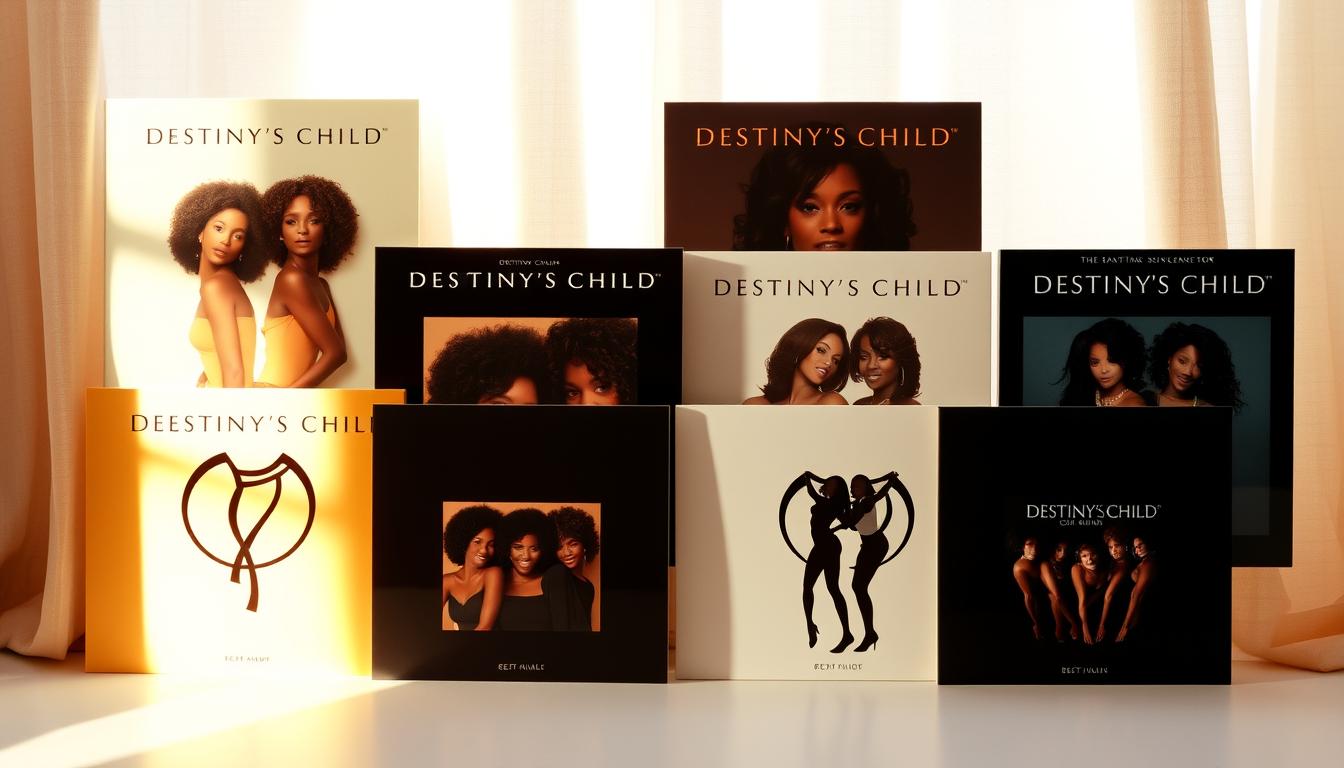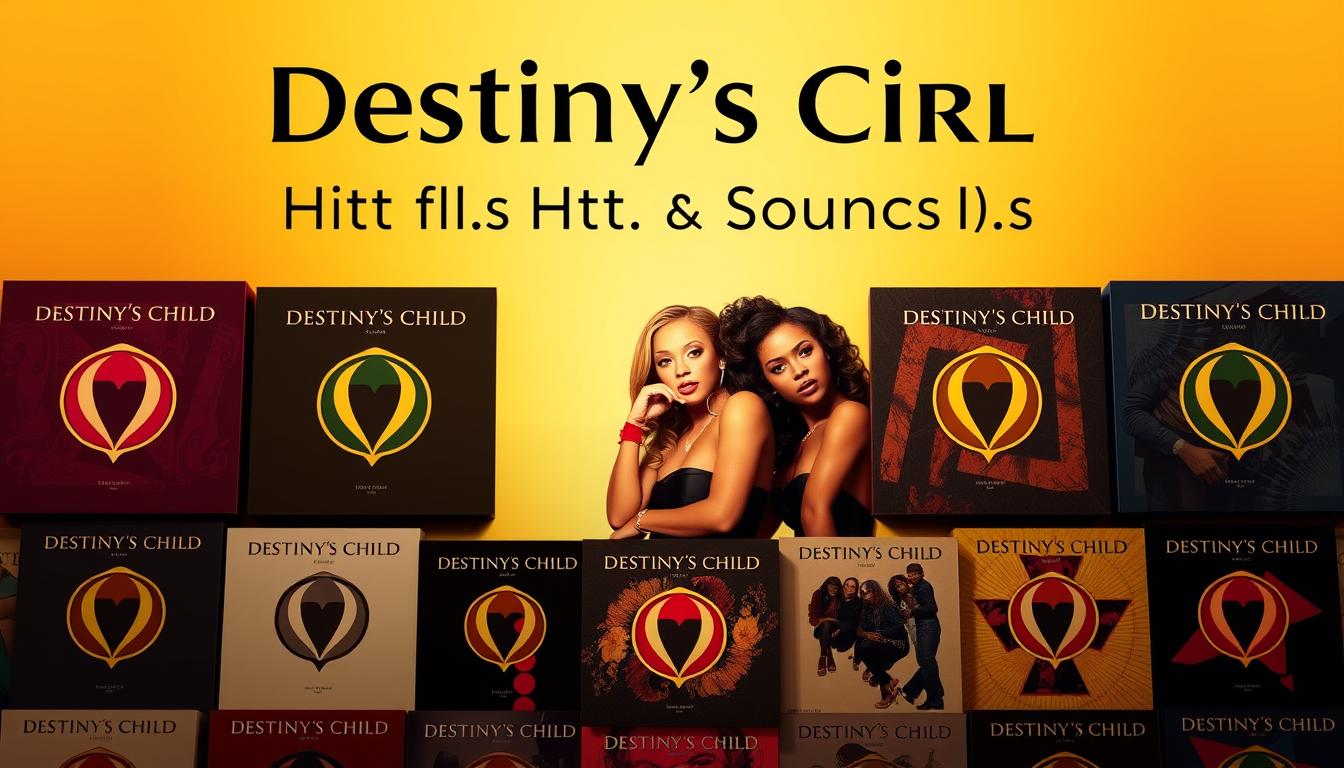The iconic R&B girl group Destiny’s Child has left an indelible mark on the music industry. Led by the talented Beyoncé, the group has produced numerous chart-topping hits and has been a driving force in shaping the sound of contemporary R&B.

This comprehensive guide will explore the group’s discography, including their studio albums, singles, EPs, and compilation albums. With a career spanning over a decade, Destiny’s Child has released music that continues to inspire and influence new generations of artists and fans alike.
Key Takeaways
- Explore the complete Destiny’s Child discography, including studio albums, singles, and compilation albums.
- Discover the group’s most notable releases and achievements.
- Learn about the impact of Destiny’s Child on the music industry and contemporary R&B.
- Get an overview of the group’s history and significance.
- Find out how Beyoncé rose to fame as the lead singer of Destiny’s Child.
The Rise of Destiny’s Child
The story of Destiny’s Child is one of perseverance and talent, beginning with their formation in the late 1990s. The group’s origins date back to the early 1990s when Beyoncé Knowles, Kelly Rowland, and other local talents came together to form Girl’s Time.
Formation and Early Years
Initially, Girl’s Tyme consisted of several members, including Beyoncé, Kelly Rowland, LaTavia Roberson, and LeToya Luckett. They performed locally in Houston, Texas, and eventually caught the attention of Mathew Knowles, Beyoncé’s father, who became their manager. Under his guidance, the group began to take shape, and their name was later changed to Destiny’s Child in 1996.
The early years were marked by lineup changes and challenges. Despite these hurdles, the group persisted, driven by their passion for music and performance. Their big break came when they signed with Columbia Records in 1997.
Evolution of the Group’s Lineup
As Destiny’s Child progressed, the lineup underwent significant changes. The original members were Beyoncé, Kelly Rowland, LaTavia Roberson, and LeToya Luckett. However, by 2000, the lineup had stabilized with Beyoncé, Kelly Rowland, and Michelle Williams as the core members. This lineup change marked a new era for the group, leading to their increased success and popularity.
The evolution of Destiny’s Child was not just about the members; it was also about their music and style. They transitioned from a more traditional R&B sound to a contemporary style that captivated a wider audience.
Complete Destiny’s Child Discography: Studio Albums
With four studio albums, Destiny’s Child showcased their musical evolution and talent. Their discography is a testament to their growth as artists and their ability to produce hits that resonated with a wide audience.
Destiny’s Child (1998)
Their self-titled debut album, released in 1998, introduced Destiny’s Child to the music scene. The album featured a mix of R&B and hip-hop, showcasing the group’s early style.
Key Tracks and Production
Key tracks from the album included “No, No, No” and “With Me.” The production was handled by notable figures such as Mathew Knowles, the group’s manager and father of Beyoncé.
Commercial Performance
The album was moderately successful, laying the groundwork for their future hits. It was a starting point for the group, demonstrating their potential.
The Writing’s on the Wall (1999)
The Writing’s on the Wall, released in 1999, marked a significant breakthrough for Destiny’s Child. The album included hit singles that catapulted the group to fame.
Breakthrough Success
Tracks like “Say My Name” and “Jumpin’, Jumpin'” became huge hits, with “Say My Name” being a standout single that reached the top of the charts.
Critical Reception
The album received positive reviews for its catchy melodies and harmonies. Critics praised the group’s vocal abilities and the album’s production quality.
Survivor (2001)
Survivor, released in 2001, further solidified Destiny’s Child’s position in the music industry. The album’s themes of empowerment and survival resonated with listeners.
Hit Singles and Themes
The title track “Survivor” and “Bootylicious” were major hits, with the latter becoming a cultural phenomenon. The album’s themes were reflected in its music videos and marketing.
Global Impact
Survivor was a commercial success globally, topping charts in multiple countries and selling millions of copies worldwide.
| Album Title | Release Year | Notable Singles |
|---|---|---|
| Destiny’s Child | 1998 | No, No, No |
| The Writing’s on the Wall | 1999 | Say My Name, Jumpin’, Jumpin’ |
| Survivor | 2001 | Survivor, Bootylicious |
| Destiny Fulfilled | 2004 | Lose My Breath, Soldier |
Destiny Fulfilled (2004)
Destiny Fulfilled, released in 2004, was the group’s final studio album before their initial breakup. It was a fitting conclusion to their discography, with hits that left a lasting legacy.
Farewell Album Significance
The album was significant as it marked the end of an era for Destiny’s Child. It included songs that reflected on their journey and future aspirations.
Musical Direction and Legacy
The album’s musical direction was a blend of R&B, pop, and hip-hop, showcasing the group’s versatility. Destiny Fulfilled contributed to the group’s lasting legacy in the music industry.
EPs and Compilation Albums
The group’s versatility is showcased in their EPs and compilation albums, offering fans a broader musical experience. These releases not only expanded their discography but also provided new perspectives on their classic hits.
8 Days of Christmas (2001)
Released in 2001, 8 Days of Christmas is Destiny’s Child’s Christmas EP. It featured traditional holiday songs along with original tracks, showcasing the group’s ability to adapt to different genres. The EP was a commercial success and has become a holiday classic.
This Is the Remix (2002)
In 2002, Destiny’s Child released This Is the Remix, a compilation album featuring remixes of their popular singles. The album was a testament to the group’s ability to reimagine their hits in various styles, appealing to a wide range of audiences.
#1’s and Other Collections
Destiny’s Child also released several compilation albums, including #1’s, which featured their most successful singles. These collections highlighted the group’s chart-topping achievements and provided fans with a comprehensive overview of their musical journey.
| Release | Year | Notable Tracks |
|---|---|---|
| 8 Days of Christmas | 2001 | 8 Days of Christmas, Winter Paradise |
| This Is the Remix | 2002 | Bootylicious (Rock wilder Remix), Say My Name (Timberland Remix) |
| #1’s | 2005 | Survivor, Independent Women Part 1 |
These EPs and compilation albums demonstrate Destiny’s Child’s musical flexibility and their ability to engage with fans through different formats. By exploring these releases, fans can gain a deeper appreciation for the group’s artistry and legacy.
Destiny’s Child Singles Chronology
Destiny’s Child’s music legacy is built on the back of their memorable and catchy singles. Throughout their career, the group released numerous singles that became chart-topping hits, showcasing their vocal talent and captivating audiences worldwide.

Breakthrough Singles (1997-1999)
The group’s early success was fueled by singles like “Say My Name” and “Bills, Bills, Bills”. These songs introduced Destiny’s Child to a wider audience and set the stage for their future success.
Peak Success Singles (2000-2001)
As the group gained momentum, they released singles that reached the top of the charts. “Independent Women Part 1” was a standout hit, featured on the Charlie’s Angels soundtrack. Other successful singles from this period include “Survivor” and “Bootylicious”.
Later Hits and Final Releases (2004-2005)
In the later stages of their career, Destiny’s Child continued to release hit singles. “Lose My Breath” and “Soldier” (featuring T.I. and Lil Wayne) were notable releases that maintained the group’s popularity.
Post-Breakup Singles and Reunions
Although the group disbanded in 2005, their music continued to be celebrated. In 2013, Destiny’s Child reunited for a performance at the Super Bowl halftime show, reigniting interest in their discography. The group’s singles remain iconic, with many still receiving airplay today.
Chart Achievements and Record Sales
Destiny’s Child achieved remarkable success on the charts throughout their career, leaving a lasting impact on the music industry. Their chart-topping hits and albums are a testament to their talent, versatility, and enduring popularity.
Billboard Chart History
Destiny’s Child had a significant presence on the Billboard charts, with numerous singles and albums achieving top positions. Their debut single “No, No, No” reached No. 3 on the Billboard Hot 100, setting the stage for their future success. The group’s subsequent releases, including “Say My Name” and “Survivor,” continued to dominate the charts, with “Survivor” reaching No. 2 on the Billboard Hot 100.
International Chart Success
In addition to their success on the Billboard charts, Destiny’s Child achieved significant international chart success. Their music resonated with fans worldwide, with hits like “Bootylicious” and “Independent Women Part 1” charting in numerous countries. The group’s international appeal was further demonstrated by their inclusion on the UK Singles Chart, where they had multiple top 10 hits.
RIAA Certifications and Global Sales
Destiny’s Child’s commercial success is also reflected in their RIAA certifications and global sales. The group’s albums, including “The Writing’s on the Wall” and “Survivor,” have been certified multi-platinum by the RIAA, indicating sales of millions of copies. Worldwide, Destiny’s Child has sold over 65 million records, making them one of the best-selling girl groups of all time.
Their chart achievements and record sales are a testament to Destiny’s Child’s enduring legacy and influence on the music industry.
Music Videos and Visual Identity
Through their innovative and stylish music videos, Destiny’s Child cemented their status as trailblazers in the entertainment industry. Their visual identity was a crucial element of their appeal, captivating audiences worldwide with a blend of style, talent, and charisma.
Iconic Video Moments and Aesthetics
Destiny’s Child’s music videos were more than just promotional tools; they were mini-stories that showcased the group’s talent and aesthetic. Videos like “Say My Name” and “Survivor” featured iconic moments that became ingrained in pop culture. The group’s ability to convey powerful messages through their visuals was a key factor in their enduring success.
Fashion Evolution and Cultural Impact
The group’s fashion evolution was closely watched by fans and media alike. From their early days with baggy clothes to their later, more polished looks, Destiny’s Child influenced a generation of young women with their style. Their music videos served as a platform for showcasing the latest trends, making them fashion icons of their time.
| Video Title | Release Year | Notable Features |
|---|---|---|
| Say My Name | 2000 | Innovative choreography, memorable storyline |
| Survivor | 2001 | Powerful message, striking visuals |
| Independent Women Part 1 | 2000 | Feminist anthem, sleek fashion |
Tours and Live Performances
The group’s live shows were a testament to their dedication to their craft, featuring intricate choreography and engaging stage presence. Destiny’s Child was known for their high-energy performances that left a lasting impression on their fans.
Major Concert Tours
Destiny’s Child embarked on several major concert tours throughout their career, including the Destiny’s Child World Tour and the Destiny Fulfilled… And Loving’ It Tour. These tours were critically acclaimed and commercially successful, featuring elaborate stage designs and a mix of their hit songs.
The tours not only showcased the group’s musical talent but also their ability to deliver high-quality performances night after night. The Destiny Fulfilled… And Loving’ It Tour was particularly notable, as it marked one of their last major tours before their initial breakup.
Memorable Television and Award Show Performances
Destiny’s Child made numerous memorable appearances on television and at award shows, including performances on MTV Video Music Awards and the American Music Awards. Their performances were often highly anticipated and generated significant buzz.
One of their most iconic performances was at the 2001 Super Bowl halftime show, where they performed in front of a massive audience. Such performances cemented their status as one of the leading girl groups of their time.
Reunion Performances
After their initial breakup, Destiny’s Child reunited for a few select performances, including a Survivor reunion at the 2013 Super Bowl halftime show and a one-off performance at the 2015 Coachella Valley Music and Arts Festival was not done but they did perform at the 2018 Essence Music Festival and a 2018 Verizon’s Super Saturate concert. These reunions were met with excitement from fans and served as a reminder of the group’s enduring legacy.
Solo Careers and Side Projects During Destiny’s Child Era
As the popularity of Destiny’s Child grew, so did the members’ interests in exploring solo projects and collaborations. This period was marked by significant individual achievements, showcasing the diverse talents within the group.
Beyoncé’s Early Solo Work
Beyoncé’s solo career began to take shape with her feature on Jay-Z’s song “Face Off.” She then released her debut solo album, “Dangerously in Love,” which included hit singles like “Crazy in Love” and “Baby Boy.” This album was a commercial success, establishing Beyoncé as a formidable solo artist.

Kelly Rowland’s Individual Projects
Kelly Rowland also pursued solo projects, releasing her debut album “Simply Deep” in 2002. The album featured the hit single “Dilemma,” a collaboration with Nelly, which became a huge success. Rowland continued to work on her solo career, exploring different musical styles and collaborating with various artists.
Michelle Williams’ Solo Ventures
Michelle Williams, known for her powerful vocals, released her debut solo album “Heart to Yours” in 2002. The album was a gospel music project, showcasing Williams’ roots and versatility. She continued to explore gospel and pop music in her subsequent solo works.
| Member | Solo Project | Release Year |
|---|---|---|
| Beyoncé | Dangerously in Love | 2003 |
| Kelly Rowland | Simply Deep | 2002 |
| Michelle Williams | Heart to Yours | 2002 |
The solo endeavors of Destiny’s Child members not only highlighted their individual talents but also contributed to the group’s overall success by keeping their fan base engaged across multiple projects.
Conclusion: The Enduring Legacy of Destiny’s Child
Destiny’s Child has left an indelible mark on the music industry, and their legacy continues to inspire new generations of artists and fans. As a pioneering R&B group, they paved the way for future female artists, showcasing their talent, style, and charisma.
The group’s impact on the music industry is still felt today, with their hits like “Say My Name” and “Survivor” remaining iconic. Their influence can be seen in many contemporary artists who cite Destiny’s Child as a source of inspiration. The enduring impact of Destiny’s Child is a testament to their innovative music, captivating performances, and trailblazing spirit.
As a cultural phenomenon, Destiny’s Child has transcended their music to become a cultural touchstone, symbolizing female empowerment and friendship. Their legacy serves as a reminder of the power of collaboration, creativity, and perseverance. The group’s contributions to the R&B genre have cemented their place in music history, ensuring their music and message continue to resonate with audiences worldwide.
FAQ
What is the complete Destiny’s Child discography?
The Destiny’s Child discography includes four studio albums: Destiny’s Child (1998), The Writing’s on the Wall (1999), Survivor (2001), and Destiny Fulfilled (2004), as well as several EPs and compilation albums, such as 8 Days of Christmas (2001) and #1’s.
What are some of Destiny’s Child most popular singles?
Some of Destiny’s Child most popular singles include “Say My Name,” “Independent Women Part 1,” “Survivor,” “Bootylicious,” and “Lose My Breath.”
What was the significance of Destiny’s Child’s final album, Destiny Fulfilled?
Destiny Fulfilled was the group’s fourth and final studio album, released in 2004. It marked the end of an era for Destiny’s Child and featured the hit singles “Lose My Breath” and “Soldier.”
Did Destiny’s Child release any EPs or compilation albums?
Yes, Destiny’s Child released several EPs and compilation albums, including 8 Days of Christmas (2001), This Is the Remix (2002), and #1’s.
What were some of Destiny’s Child’s chart achievements?
Destiny’s Child achieved significant chart success, with numerous singles and albums charting on the Billboard charts. They had multiple number one singles, including “Independent Women Part 1” and “Survivor.”
How did Destiny’s Child influence the music industry?
Destiny’s Child had a significant impact on the music industry, paving the way for future generations of female R&B artists. Their music and style continue to be cited as an inspiration by many contemporary artists.
What were some of the solo projects pursued by Destiny’s Child members during their time together?
During their time together as Destiny’s Child, the individual members pursued solo projects, including Beyoncé’s early solo work, Kelly Rowland’s individual projects, and Michelle Williams’ solo ventures.
Did Destiny’s Child ever reunite after disbanding?
Yes, Destiny’s Child reunited for a few performances, including a Super Bowl halftime show performance in 2013 and a one-off performance at the 2018 Coachella Valley Music and Arts Festival.
